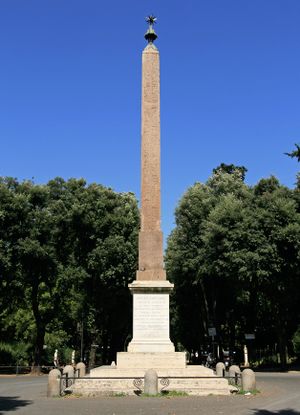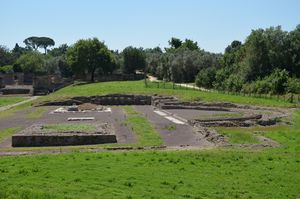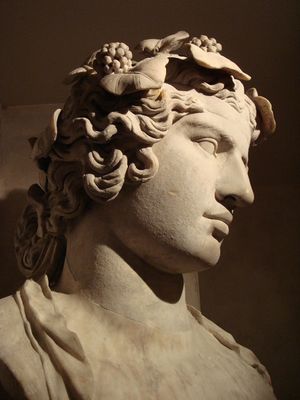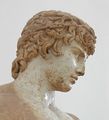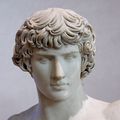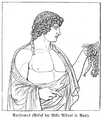أنتينوس
أنتينوس Antinous ؛ باليونانية قديمة: Ἀντίνοος؛ 27 نوفمبر ح. 111 &ndash؛ قبل 30 أكتوبر 130[1])، هو شاب يوناني بيثيني وأثير أو حبيب، الامبراطور الروماني هادريان.[2] تم تأليهه بعد وفاته، ليعبد في كلاً من الشرق اليوناني والغرب اللاتيني، وأحياناً كإله (ثيوس) وأحيان نادرة كبشري مؤله (هـِروس).[3]
لا يعرف عن حياة أنتينوس إلا القليل، بالرغم من أن من المعروف أنه وُلد في كلوديوپوليس (بولو، تركيا حالياً)، في مقاطعة بيثينيا الرومانية. ومن المرجح أنه قدم لهادريان عام 123، قبل أن يؤخذ إلى إيطاليا ليتلقى تعليمه العالي. أصبح مقرب لهادريان بحلول 128، عندما أُخذ في جولة بالامبراطورية كجزء من حاشية هادريان الشخصية. رافق أنتينوس هادريان أثناء حضوره احتفال أسرار اليوسيس السنوي في أثينا، وكان معهم عندما قتل الأسد الماروسيني في ليبيا. في أكتوبر 130، كانوا جزء من الأسطول المبحر في النيل، توفى أنتينوس في ظروف غامضة. هناك اقترحات مختلفة عن وفاته، تتراح بين حادث غرق أو تقديمه عن قصد كقربان بشري.
بعد وفاته، ألهه هادريان وأسس عباة منظمة مكرسة لعبادته التي انتشرت في أرجاء الامبراطورية. أسس هادريان مدينة أنتينوپوليس بالقرب من مكان وفاة أنتينوس، والتي أصبحت مركزاً لعبادة أوزوريس-أنتينوس. كما أقام هادريان الألعاب تكريماً لأنتينوس في كلاً من أنتينوپوليس وأثينا، ليصبح أنتينوس رمزاً لأحلام هادريان بالقومية الهلينية.
أصبح أنتينوس مرتبطاً بالمثلية الجنسية في الثقافة الغربية، وهو يظهر في أعمال اوسكار وايلد والشاعر الپرتغالي فرناندو پيسوا.
حياته
طفولته
حياته مع هادريان

وفاته
تأليه وعبادة أنتينوس

أنتينوپوليس
انتشار العبادة

الإدانة والتراجع
أنتينوس في المنحوتات الرومانية
Antinous Ecouen، من ڤيلا أدريانا في تيڤولي.
تمثال نصفي لأنتنينوس في متحف پلازو ألتمپس، روما.
Vatican Museums, colossal bust, from Villa Adriana
في شخصية باخوس، متاحف كاپيتولين.
أنتينوس ككاهن في العبادة الامبراطورية.
كاپيتولين أنتينوس، متاحف كاپيتولين، من ڤيلا أدريانا.
نقش بارز من ڤيلا ألباني من مجموعة تورلونيا، روما.
نقش بارز لأنتينوس في شخصية سيلڤانوس، متحف روما الوطني.
أنتينوس في شخصية أوزوريس.
رأس (التمثال النصفي حديث)، Antikensammlung Berlin
تمثال ممصر لأنتينوس، المتحف الأثري الوطني في أثينا.
أنتينوس في شخصية أوزوريس، عُثر عليه في أطلال ڤيلا هادريان في القرن 18.
نحت لأنتينوس في أراضي القصر الجديد، پوستدام.
الإشارات الثقافية
المصادر
الهوامش
- ^ The day and month of his birth come from an inscription on a tablet from Lanuvium dated 136 AD; the year is uncertain, but Antinous must have been about 18 when he drowned, the exact date of which event is itself not clear: certainly a few days before 30 Oct. 130 AD when Hadrian founded the city of Antinoöpolis, possibly on the 22nd (the Nile festival) or more likely the 24th (anniversary of the death of Osiris). See Lambert, p. 19, and elsewhere.
- ^ Birley 2000, p. 144.
- ^ Renberg, Gil H.: Hadrian and the Oracles of Antinous (SHA, Hadr. 14.7); with an appendix on the so-called Antinoeion at Hadrian’s Villa and Rome’s Monte Pincio Obelisk, Memoirs of the American Academy in Rome, Vol. 55 (2010) [2011], 159-198; Jones, Christopher P., New Heroes in Antiquity: From Achilles to Antinoos (Cambridge, Mass. & London, 2010), 75-83; Bendlin, Andreas: Associations, Funerals, Sociality, and Roman Law: The collegium of Diana and Antinous in Lanuvium (CIL 14.2112) Reconsidered, in M. Öhler (ed.), Aposteldekret und antikes Vereinswesen: Gemeinschaft und ihre Ordnung (WUNT 280; Tübingen, 2011), 207-296.
المراجع
- Birley, A.R (2000). "Hadrian to the Antonines". In Alan K. Bowman, Peter Garnsey, Dominic Rathbone (ed.). The Cambridge ancient history: The High Empire, A.D. 70-192. Cambridge University Press.
{{cite book}}: CS1 maint: multiple names: editors list (link) - Lambert, Royston (1984). Beloved and God: The Story of Hadrian and Antinous. George Weidenfeld & Nicolson.
{{cite book}}: Invalid|ref=harv(help) - Opper, Thorsten (1996). Hadrian: Empire and Conflict. Harvard University Press.
{{cite book}}: Invalid|ref=harv(help) - Vermeule, Cornelius Clarkson (1979). Roman art: early Republic to late Empire. Boston Museum of Fine Arts.
- Vout, Caroline (2005). "Antinous, Archaeology, History". The Journal of Roman Studies. Society for the Promotion of Roman Studies. 95: 80–96. doi:10.3815/000000005784016342. JSTOR 20066818.
{{cite journal}}: Invalid|ref=harv(help) - Vout, Caroline (2007). Power and Eroticism in Imperial Rome. Cambridge: Cambridge University Press.
{{cite book}}: Invalid|ref=harv(help) - Waters, Sarah (1995). ""The Most Famous Fairy in History": Antinous and Homosexual Fantasy". Journal of the History of Sexuality. University of Texas Press. 6 (2): 194–230. JSTOR 3704122.
{{cite journal}}: Invalid|ref=harv(help) - Wilson, R.J.A (1998). "Roman art and architecture". In John Boardman (ed.). The Oxford history of the Roman world. Oxford University Press.
قراءات إضافية
- Grenier, L'Osiris Antinoos (2008) (online).
- John Addington Symonds, 'Antinous', in J. A. Symonds, Sketches And Studies In Italy (1879), p. 47-90
مراجع أدبية قديمة
- Biography of Hadrian in the Augustan History (attributed to Aelius Spartianus)
- Cassius Dio, epitome of book 69
وصلات خارجية
- The Temple of Antinous, Ecclesia Antinoi
- Antinous Homepage - various facets of the Antinous topic
- Cassius Dio's Roman History, epitome of Book 69
- Antinous: A poem by Fernando Pessoa. Lisbon: Monteiro, 1918.
- «Antinous» in English Poems I-II. Lisbon: Olisipo, 1921, pp. 5-16.
- Sculpture of Antinous at the Lady Lever Art Gallery
- Virtual Museum: Portraits of Antinous
- Articles with hatnote templates targeting a nonexistent page
- Articles containing Ancient Greek (to 1453)-language text
- مواليد 111
- وفيات 130
- يونانيو القرن الثاني
- رومان القرن الثاني
- وفيات بالغرق
- أشخاص مألهون
- رجال مثليون
- هادريان
- تاريخ الشذوذ الجنسي
- المثلية الجنسية والديانة
- تاريخ المثلية الجنسية قبل القرن 19
- آلهة الحياة-الموت-البعث
- مثليو ما قبل القرن 19
- أساطير رومانية
- Male lovers of royalty


